The only 10 Christmas dinner recipes you’ll ever need
With less than a week to go, Hannah Twiggs brings you the ultimate guide to the pulling off the perfect Christmas feast. Whether you’re all about tradition or ready to shake things up, these recipes promise flavour, theatrics and zero stress – because this year, the kitchen should be as joyful as the table

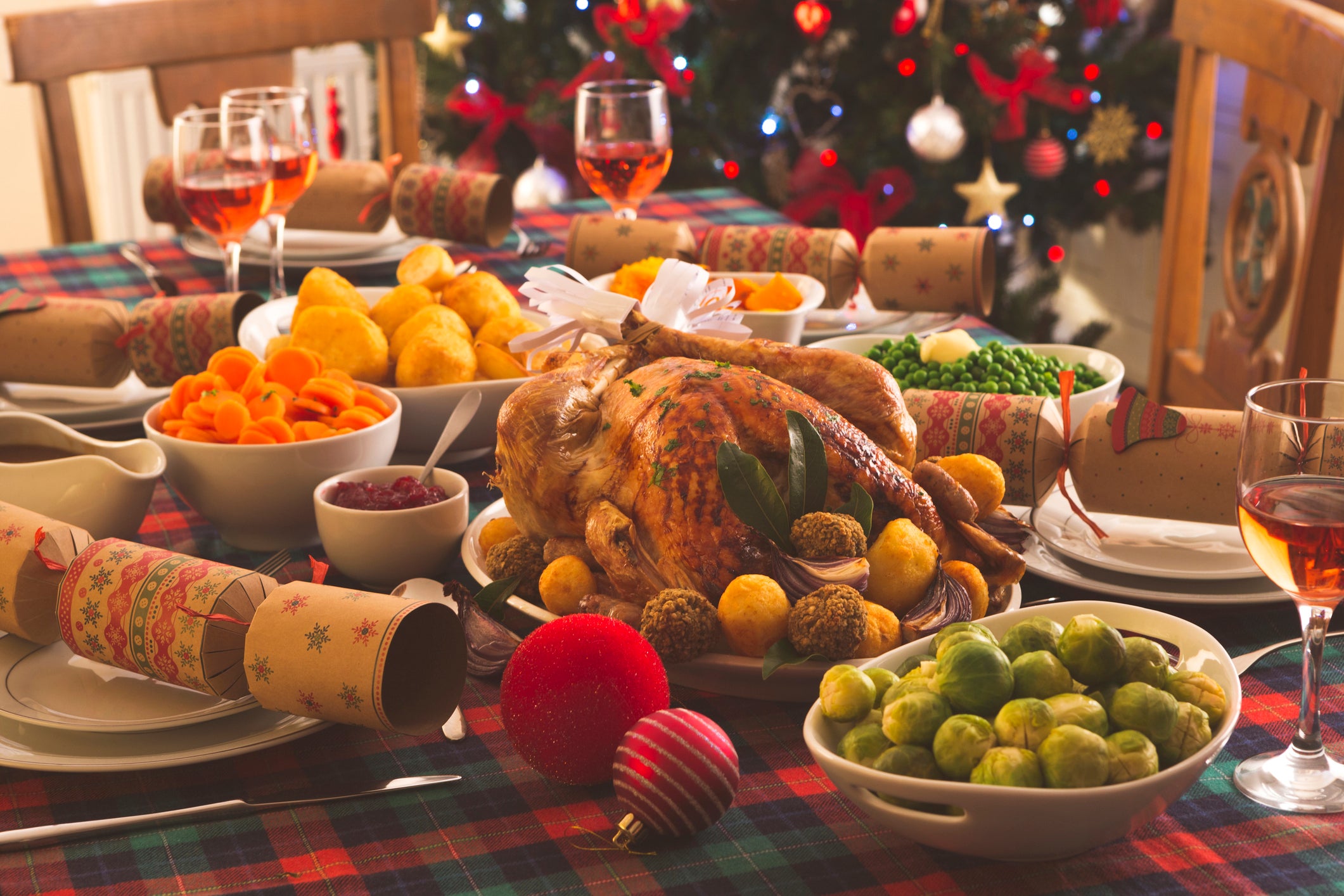
There’s something uniquely British about overthinking Christmas dinner. We panic about dry turkey, argue over the merits of goose and feel a pang of guilt about how far the sprouts have travelled. It’s the meal that’s supposed to be perfect, as if each plate carries the weight of an entire year. And yet, every December we make it harder on ourselves, turning kitchens into war zones and attempting culinary stunts no one asked for. It’s time to simplify things.
This isn’t about cutting corners; it’s about making Christmas dinner feel less like a chore and more like the celebration it’s meant to be. The mains we’ve chosen from our archive are more than just crowd-pleasers – they’re recipes that know how to deliver both flavour and theatrics without breaking you.
From Gordon Ramsay’s foolproof turkey where herb butter ensures every slice is juicy to Jamie Oliver’s stuffed squash, a vegan masterpiece of nutty cranberry-laced rice encased in sweet caramelised flesh, these dishes are tested, timeless and designed to impress.
For those who want to shake tradition, there’s James Mackenzie’s five-bird roast, a Yorkshire classic as opulent as it sounds, or Rick Stein’s low-and-slow topside, a masterclass in making tough cuts tender. Whether you’re feeding two or 22, these mains cover all bases. Meat, game, plant-based – each dish has its own moment to shine.
So, put down the stress and pick up the carving knife. This is Christmas dinner done right: no panic, just perfect plates.
Perfect roast turkey

Even the mention of Gordon Ramsay is enough to inspire confidence in the kitchen, and when it comes to Christmas turkey, his approach delivers every time. Ramsay’s recipe is a masterclass in ensuring moist, flavourful meat, taking the guesswork out of the star dish of the festive feast. The secret? A rich herb butter massaged under the skin, a bouquet of aromatics in the cavity and a final bacon-lattice crown that keeps things succulent while adding just the right hint of smokiness. The result? A turkey so good you’ll wonder why it’s only reserved for December.
Serves: 8-10
Ingredients:
1 free-range turkey (ideally Norfolk Black or Bronze), about 5-5.5kg
Sea salt and freshly ground black pepper
2 onions, peeled and halved
1 lemon, halved
1 head of garlic, halved horizontally
6 bay leaves
Olive oil, to drizzle
8 rashers of smoked streaky bacon
For the lemon, parsley and garlic butter:
375g butter, at room temperature
1 tbsp olive oil
Finely grated zest and juice of 2 small lemons
3 garlic cloves, peeled and crushed
Small bunch of flat-leaf parsley, leaves only, chopped
Method:
1. Preheat the oven to 220C/gas 7. Meanwhile, prepare the herb butter. Put the butter into a large bowl and season with salt and pepper. Add the olive oil and mix well. Add the lemon zest and juice, crushed garlic and chopped parsley. Mix well to combine.
2. Remove the giblets from the turkey cavity. Season the cavity well with salt and pepper, then stuff with the onions, lemon, garlic halves and two bay leaves.
3. With your hands, loosen the skin on the breast from both ends of the bird so that you will be able to stuff the flavoured butter underneath it, making sure you keep the skin intact. Repeat with the skin on the legs – from the lower side of the breast feel your way under the skin and out towards the leg, loosening the gap.
4. Stuff half the butter mix into the opened spaces under the skin. From the outside of the skin, gently massage the butter around the breasts so that the meat is evenly covered. Finally, insert the rest of the bay leaves under the skin of the breasts.
5. Place the bird in a large roasting tray, breast side up. Spread the rest of the butter all over the skin. Season well with salt and pepper, then drizzle with a little olive oil. (If preparing a day ahead, cover the turkey with foil and refrigerate at this stage.)
6. Roast the turkey in the hot oven for 10-15 minutes. Take the tray out of the oven, baste the bird with the pan juices and lay the bacon rashers over the breast to keep it moist. Baste again. Lower the setting to 180C/Gas 4 and cook for about two and a half hours (calculating at 30 minutes per kilogram), basting occasionally.
7. To test whether your turkey is cooked, insert a skewer into the thickest part of the leg and check that the juices are running clear, rather than pink. As oven temperatures and turkey shapes and sizes vary, it is crucial to check your turkey about 30 minutes before the calculated roasting time. If the juices are pink, roast for another 15 minutes and check again. Repeat as necessary until the turkey is cooked.
8. Transfer the turkey to a warmed platter and remove the parson’s nose, wings and tips of the drumsticks; reserve these for the gravy. Leave the turkey to rest in a warm place for at least 45 minutes; make the gravy in the meantime. Remove the bay leaves from under the skin before carving. Serve the turkey with the piping hot gravy, stuffing and accompaniments.
Roasted turkey crown with duck fat, and chestnut stuffing in savoy cabbage leaves

For those looking to impress without the commitment of a whole bird, Matt Tebbutt’s turkey crown is the thinking cook’s solution. Brined to perfection for ultimate flavour and paired with a standout stuffing wrapped in Savoy cabbage, this recipe feels like a gourmet upgrade for your table. Tebbutt, a familiar face on weekend TV, brings his knack for no-fuss elegance here, balancing tradition with clever twists. The duck fat adds richness, while the brining ensures your meat is melt-in-the-mouth tender. Roast this for a modern twist on festive fare.
Ingredients:
For the brine:
6.5kg free-range turkey
5 litres water
2 tsp table salt
2 tsp black peppercorns
1 cinnamon stick
1 tsp whole cloves
½ tsp caraway seeds
Star anise
1 tbsp dark brown sugar
250ml white wine
½ tsp mustard seeds
2 onions, chopped
4 garlic cloves, crushed
For roasting the turkey:
1 onion, peeled and halved
1 large carrot, peeled and quartered
2 sticks celery halved
2 cloves garlic, peeled
Drizzle of olive oil
Bay leaves
Small bunch of thyme
Pepper for seasoning
Bacon rashers (optional) for the breast
1 bulb garlic, halved
For the stuffing:
1 savoy cabbage
6 sausages, removed from their skins
200g chestnuts, chopped
4 sprigs thyme
1 garlic clove
2 tbsp goose fat
Salt and pepper
For the gravy:
1 pint chicken or turkey stock
1 large glass port
1 tbsp flour
Method:
1. For the brine, in a large pot add the water. Add in all of the turkey brine ingredients – stir to dissolve salt and sugar. Remove any string attached to the turkey, remove the legs from the turkey and put them back in the fridge covered. Add the turkey breast and crown to the liquid – add more liquid if needed. Bring up to the boil and then let it cool to room temperature. Put in the fridge or if the pot doesn’t fit somewhere cold, even outside. Leave for 24/48 hours.
2. For the turkey, sit your brined turkey on a roasting tray over the onion, garlic, carrot and celery. If desired layer or lattice rashers of bacon over the breast to protect in the oven. Take the legs out of the fridge, place in a roasting tray, baste with goose fat, dress with thyme, and a halved bulb of garlic.
3. Roast the turkey for 15 minutes, then reduce the oven temperature to 160C and roast for a further 2 ½-3 hours until cooked, basting every 30 minutes, and covering it with foil once it’s golden brown, to prevent over-colouring. Remove from the oven and leave to rest for 1-1½ hours in a warm place.
4. For the stuffing, preheat the oven to 130C. Cook the cabbage in salted water, drain and run under cold water. Mix up all of the stuffing ingredients together and season. Line an oven-proof terrine dish with 2 layers of cling film leaving enough to completely cover the cabbage. Cover the base and sides of the oven-proof dish with the cabbage leaves. Arrange the sausage meat over the cabbage, around halfway up and press down. Finely chop some of the cabbage and layer in the middle of the meat. Layer on the remaining sausage meat and finish with a final layer of the cabbage. Cover tightly with the cling film and put it into the oven for 40-50 minutes. Remove it from the oven, the cabbage should be tender and allow it to cool. Carefully turn out the parcel and remove the cling film. Slice it into wedges and serve it.
5. For the gravy, from the turkey roasting tin, strain the juices and reserve for later, leave the onion, carrot celery garlic and a little fat and juice in the pan. Heat over a medium heat. Add a tablespoon of flour and mix with the fat in the pan. When the flour and juices have combined add the large glass of port and mix well. Add the reserved juices from the turkey, stir then add a pint of chicken or turkey stock. Reduce by about half.
Five-bird roast

A centrepiece fit for royalty, James Mackenzie’s five-bird roast brings the traditional “Yorkshire pot” to life with precision and flair. Famous for his work at the Michelin-starred Pipe and Glass, Mackenzie elevates the concept, layering duck, grouse, pheasant, partridge and chicken with luxurious stuffing. Wrapped in air-dried ham and slow-cooked to perfection, this isn’t just food; it’s a conversation piece. If you’re after a showstopper for your festive table, this roast combines heritage, indulgence and unbeatable flavour in every slice.
Time: 1 hour 30 minutes cooking, plus overnight resting, 2 hours 30 minutes poaching and 1 hour 30 minutes roasting
Ingredients:
2 large duck legs
2 large duck breasts
2 large chicken breasts
300g sausagemeat
100g semi-dried cranberries
100g pistachio nuts, chopped
1 tsp juniper berries, crushed
16-20 slices air-dried ham, eg, Parma or similar
4 grouse breasts
4 pheasant breasts
6 partridge breasts
Equipment:
Sous vide equipment
Boning knife
Method:
1. Ensuring your boning knife is very sharp, bone the duck legs by cutting out and removing all of the bone and cartilage. Cut each of the duck breasts and chicken breasts into three lengthways, and slice the duck legs into strips.
2. To prepare the stuffing, place the sausagemeat, cranberries, pistachios and juniper berries in a bowl and mix thoroughly with your hands. Lay several layers of cling film, each about 60 x 30cm, out on a work surface. Lay the slices of ham onto the cling film to form a rectangular base (smaller than the cling film) to start building the roast.
3. Lay the duck breast in a line down the centre of the ham, then lay about half the stuffing mix in a thin sausage on either side of the length of the duck. Lay the chicken strips along one side of the stuffing, end-to-end to cover the exposed length of ham. Repeat with the grouse, pheasant and partridge breasts and duck leg until all of the meat (except the stuffing) is used up – the ingredients should all be laid out in even lines. Top with the remaining stuffing mix.
4. To roll the roast, take one side of the cling film and roll and wrap the ham over to encase the meat and stuffing, forming a large sausage encased in the ham and cling film. Place in the fridge to rest overnight.
5. To cook, preheat a water bath to 75C and, making sure the roast is completely sealed in cling film, cook for 2½ hours. After this time, remove from the cling film, place in a roasting tray and cook at 180C/gas mark 4 for 1-1½ hours. To check that it is cooked, slide in a sharp knife – the juices should run clear.
6. If you don’t have a water bath, remove the roast from the cling film and carefully wrap in foil. Roast in the oven at 160C/gas mark 3 for 2 hours, then remove the foil and roast for a further 1-1½ hours at 180C/gas mark 4 until the juices run clear. Remove from the oven and allow to rest for at least 20 minutes. Cut into thick slices and serve.
Recipe from Great British Chefs
Roast topside of beef

Rick Stein knows a thing or two about celebrating simple ingredients, and his topside of beef is a lesson in doing just that. Aided by low-and-slow cooking and dry-aged meat, this roast transforms a humble cut into something extraordinary. The Marmite-laced gravy – a surprising nod to umami perfection – is what seals the deal. Stein’s knack for accessible indulgence shines here, with results so tender and rich you’ll want to bookmark this recipe long after the holidays are over.
By: Rick Stein
Ingredients:
1.5kg topside of beef
1 tbsp sea salt
1 tbsp vegetable oil
For the gravy:
2 shallots, finely chopped
2 garlic cloves, finely chopped
Sprig of thyme
1 tbsp vegetable oil
1 tsp salt
375ml red wine
1l beef stock
1 tsp Marmite
2 tsp soy sauce
1 tbsp rice wine vinegar
50g unsalted butter, cold
To serve:
Roast potatoes
Steamed greens with confit shallots
Method:
1. Preheat the oven to 55C and season the beef all over with the salt. If you prefer your beef medium, set it to 60C and so on. If your oven doesn’t go this low, roast the beef at 220C fan/240C/gas 9 for 30 minutes, then drop to 180C fan/200C/gas 6 and roast until a meat probe reads 55C, which should take about 1½ hours.
2. Heat the oil in a frying pan and sear the beef on each side until golden brown (about 2 minutes each side including the ends). Deglaze the pan with 2 tbsp water; reserve these pan juices for making the gravy later.
3. Put the beef into a roasting tin and cook in the oven for a minimum of 4 hours until the internal temperature reaches the oven temperature you set.
4. Meanwhile roast your potatoes. Set aside and keep warm. When the meat is nearly finished, prepare the greens. Now make the gravy. Soften the shallots, garlic and thyme in vegetable oil in a saucepan over a medium heat and season with salt. Add the red wine and reduce until evaporated. Add the beef stock and deglazed pan juices and reduce by half. Add the Marmite, soy sauce and vinegar and reduce by another quarter. Whisk in the cold butter to finish.
5. After removing the beef from the oven, leave it to rest for 15 minutes. Slice the beef (thick or thin as you like) and serve with the greens, roast potatoes and gravy.
Recipe from ‘World on a Plate’ by Jack Stein
Beef Wellington
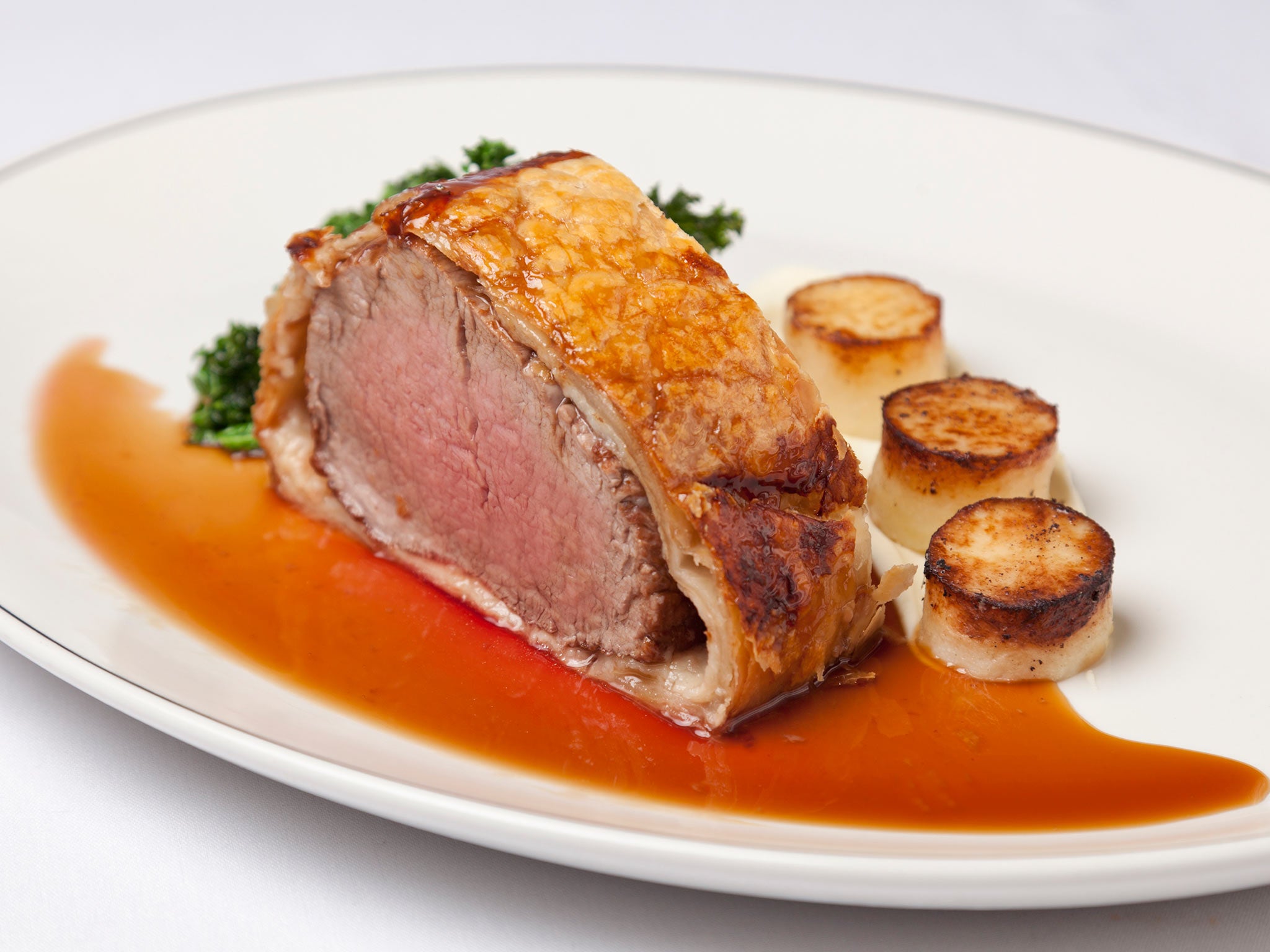
Nothing says decadence like a perfectly cooked beef Wellington, and Graham Campbell’s version is the stuff of culinary dreams. With Michelin-starred precision, Campbell blends traditional techniques with indulgent touches: golden puff pastry, a rich mushroom duxelles and tender beef fillet that’s pink in the middle. A little effort goes a long way here, and the result is the ultimate crowd-pleaser – perfect for Sunday lunch or any celebration where you want the food to take centre stage.
Ingredients:
For the beef:
800g beef fillet
Vegetable oil
Salt
For the pancake mix:
80g flour
210ml milk
2 eggs
Vegetable oil
For the Wellington:
1 sheet puff pastry
40g butter
200g mushrooms, finely chopped
2 shallots, finely diced
1 garlic clove, minced
50ml white wine
1 bunch chives, chopped
20g Dijon mustard
Method:
1. Preheat the oven to 200C/gas mark 6.
2. Heat a frying pan with a dash of vegetable oil over high heat. Season the beef fillet generously with salt and sear evenly until browned. Remove from the pan and cool completely.
3. In a bowl, whisk together one egg, flour, and milk until smooth. Heat a non-stick frying pan with enough vegetable oil to coat the base. Cook thin pancakes (crepe-style) using about 60ml of batter for each. Set aside.
4. Melt the butter in a saucepan over medium heat. Saute mushrooms, shallots, and garlic until the moisture is released and the mixture is nearly dry. Add white wine, reducing until almost dry again. Remove from heat, add chives, and blend until smooth. Season to taste and set aside.
5. Spread each pancake with Dijon mustard and the mushroom mixture. Lay the pancakes out to form a rectangular base. Wrap them tightly around the cooled beef fillet.
6. Roll out the puff pastry with the longest side parallel to you. Place the wrapped beef at one edge and roll the pastry around it, sealing the edges. Ensure the seam is on the underside.
7. Brush the pastry with a beaten egg. Chill in the fridge while preheating the oven.
8. Preheat the oven to 190C/gas mark 5. Remove the Wellington from the fridge, allow it to stand for 15 minutes, and bake for 15-20 minutes for medium-rare (internal temperature of 65C).
9. Rest the Wellington for 5 minutes before slicing into portions. Serve as desired.
Recipe from Great British Chefs
Roast rib of pork with apple dumplings
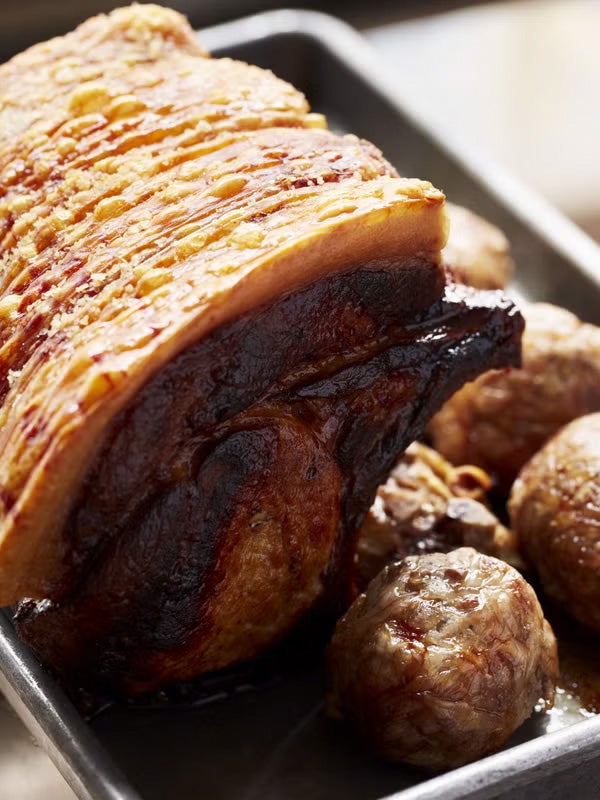
Mark Hix has a knack for taking the familiar and giving it a delicious twist, and this roast rib of pork with apple dumplings is no exception. The king of British seasonal cooking, Hix pairs succulent pork with tangy-sweet apple dumplings, striking the perfect balance between tradition and innovation. The dumplings, wrapped in delicate caul fat, are a revelation – ideal for soaking up the pork’s juices. This recipe is the epitome of comfort food with an edge, perfect for warming up your winter table.
Serves: 6
Ingredients:
For the pork:
1 six-bone rib or rack of pork, chine bone removed
Salt and freshly ground black pepper
A little vegetable or corn oil
For the apple dumplings:
180-200g coarsely minced fatty pork
50g fresh white breadcrumbs
1 large Bramley apple, peeled, cored, cooked and coarsely mashed
Salt and freshly ground black pepper
80-100g pig’s or lamb’s caul fat
Method:
To make the pork:
1. Preheat the oven to 220C/gas mark 7. Place a roasting tray with about 2-3cm of water on the stove, then place the pork, rind-side down in the water, and simmer for about 5 minutes, moving the pork around if necessary so the rind and fat gets a good blanch.
2. Remove from the water; place on a board, skin up, and discard the water from the tray. With a sharp knife, score the rind about 1cm apart and place in the roasting tray with the bones down, season; drizzle over a little oil.
3. Roast for 20-25 minutes, basting a few times, then turn the oven down to 180C/ gas mark 5 and cook for a further 35-40 minutes.
4. Remove the pork from the oven, rest for approximately 10 minutes, remove the string (if appropriate) and carve into chops.
To make the apple dumplings:
1. Mix the minced pork, breadcrumbs and apple together; season. Divide the mixture into 6 and mould into balls.
2. Cut the caul fat into pieces that are large enough to double-wrap the dumplings and then wrap them around the dumplings a couple of times.
3. Place the dumplings on a tray or with the pork; roast for 15 minutes.
The perfect lamb roast
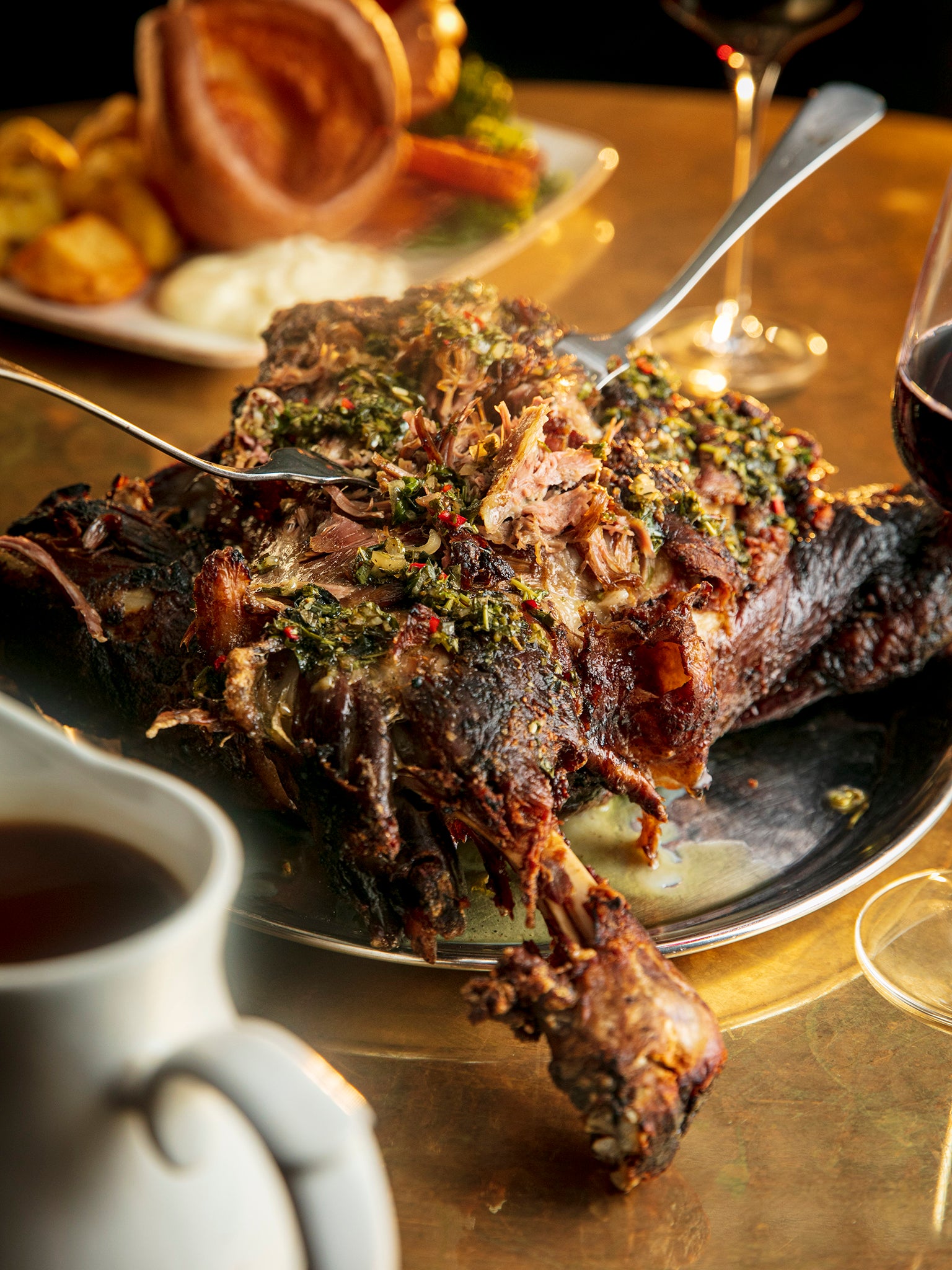
A lamb shoulder is a time commitment, but as this recipe proves, the reward is deeply satisfying. Slow-cooked with a carefully crafted BBQ rub that combines aromatic spices with a sweet-smoky undertone, the lamb emerges so tender it practically falls apart. For lovers of pulled pork, this lamb shoulder offers a sophisticated upgrade, with succulent, flavour-packed meat that works as well at a dinner party as it does at a casual family gathering.
Ingredients:
1 Lamb shoulder*
BBQ rub
150g caster sugar
150g brown sugar
150g Maldon salt
10g caraway seeds
10g fennel seeds
10g coriander seeds
20g garlic powder
10g sweet paprika
50g black pepper
* 1 lamb shoulder weighs approx 4kg when raw. It loses 50 per cent of its weight during the cooking and pulling process, which means you are left with 2kg of meat you can enjoy. An average portion of pulled lamb is around 200g, which means you can get a few good portions out of a 4kg joint.
Method:
1. Toast all the spices and finely grind using a pestle and mortar. Combine all the ingredients and set aside.
2. Rub and press the spice mix onto the meat, ensuring it coats the whole shoulder.
3. Smoke the meat between 125C to 150C till it reaches 93C, which roughly takes around six hours depending on the size of the joint.
4. During the latter stages of the cooking process apply what is known in the circle as the Texas crutch, which means we wrap the shoulder in parchment paper and foil. This helps to concentrate the maximum amount of residual heat whilst avoiding evaporation and the meat getting dry.
5. Keep it wrapped until ready to serve, it should be succulent, steaming hot and juicy!
Stuffed leg of lamb with Jersey Royal potatoes
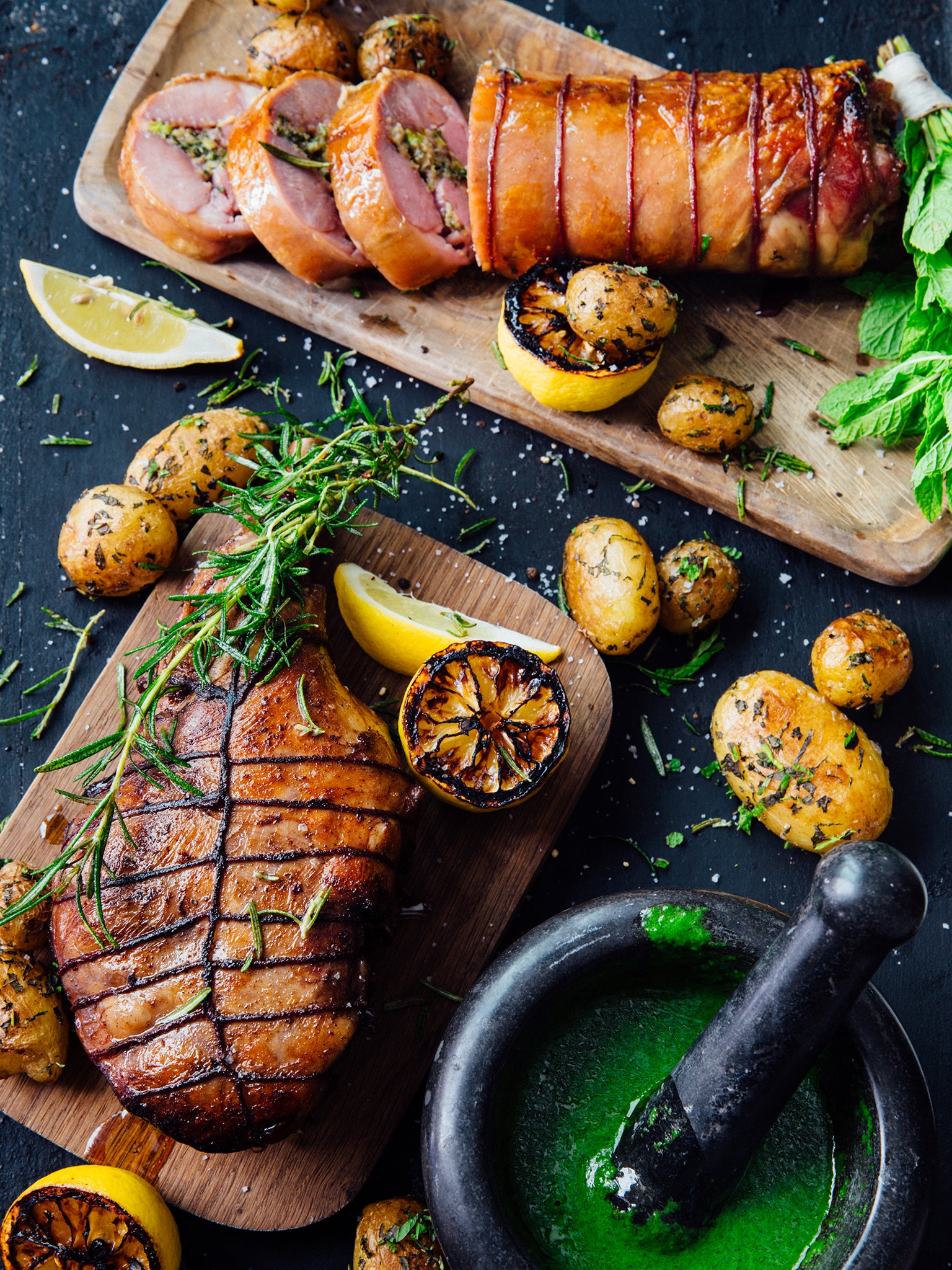
Greg Marchand of Frenchie fame brings a touch of Parisian elegance to the classic roast with this stuffed leg of lamb. Packed with a vibrant filling of mint, pistachios and parmesan, this dish is a feast for the eyes and the palate. Jersey Royals cooked in mint butter are the perfect side, adding a buttery richness to the mix. Marchand’s approach combines French finesse with British ingredients, making this dish one to remember long after the last bite.
Serves: 4
Preparation: 1 hour 30 minutes
Ingredients:
For the stuffing:
2 shallots, finely sliced
50ml water
50ml white wine vinegar
1 tsp sugar
200g mint, blanched and coarsely chopped
200g sandwich bread, toasted and cooled
45g pistachio nuts, roasted and coarsely chopped
40g parmesan cheese
3 anchovies
Dash of Tabasco sauce
2 eggs
½ tsp thyme
For the lamb:
1 leg of lamb, deboned, you can ask your butcher to remove the bone
For the Jersey Royal Potatoes:
600g Jersey Royal potatoes
200g butter
½ bunch mint, minced
Juice of 1 lemon
Pinch of salt
Method:
1. For the stuffing, combine all ingredients and cook over medium heat until the liquid evaporates and the shallots are translucent. The mixture should be moist and should hold its shape if rolled into a ball.
2. For the lamb, preheat the oven to 220C (gas mark 7).
3. Stuff the leg and tie it up. Heat the oil in a skillet or frying pan and brown the meat well on all sides. Roast the leg with 3 lemons, halved, for 30 minutes, and then reduce the temperature to 180C (gas mark 4) and cook for a further hour.
4. Take the meat out of the oven, wrap in aluminium foil, and rest for 20 minutes.
5. For the potatoes, in a stockpot, cover the potatoes with cold water and add plenty of salt. Bring to a boil and cook the potatoes until they are soft, about 20 minutes, then drain.
6. Heat the butter in a large skillet or frying pan and brown the potatoes over low heat. Add the mint and season with lemon juice and salt.
7. Serve the potatoes in a side dish. Carve the lamb at the table and serve with the roasted lemons.
Mushroom wellington

BOSH! is known for turning plant-based cooking into an art form, and their mushroom Wellington is a vegan centrepiece with undeniable festive flair. Layers of seasoned mushrooms, chestnuts and cranberries are wrapped in flaky puff pastry, delivering both comfort and decadence. Spiced with nutmeg and cinnamon and infused with earthy herbs, this is a dish that holds its own at any Christmas table.
Ingredients:
Olive oil, for drizzling
3 tbsp oil from sun-dried tomato jar
4 long shallots
8 cloves garlic
4 sun-dried tomatoes
1 carrot
1 stick celery
8 sprigs thyme
4 sprigs rosemary
2 sprigs sage
500g chestnut mushrooms
200ml red wine
2 ½ tbsp cranberry sauce
1 bay leaf
½ tsp nutmeg
½ tsp cinnamon
200g chestnuts
200g pecans
100g dried breadcrumbs
2 320g pre-rolled sheets plant-based puff pastry
2 tbsp plant-based milk
1 tbsp maple syrup
Method
1. Preheat oven to 180C. Roast your mushrooms: Lay 10 chestnut mushrooms in a row down the middle of a sheet of tin foil. Drizzle over a little olive oil, sprinkle over a little salt and pepper, lay four sprigs of thyme, two sprigs of rosemary, three cloves of garlic and a sprig of sage on top of the mushrooms. Wrap the mushrooms up tightly in the tin foil, put the parcel in the roasting tin, put the roasting tin in the oven and bake for 30 minutes.
2. Whilst the mushrooms are roasting, peel and finely slice the long shallots. Peel and finely grate the carrot. Finely dice the celery. Finely slice the sun-dried tomatoes. Peel and finely grate the garlic. Pick the leaves off four sprigs of thyme, two sprigs rosemary, one small sprig of sage and finely chop. Blitz 300g of the mushrooms in the food processor to form a mince. Blitz 100g chestnuts and 200g pecans in the food processor to form a meal. Roughly chop the remaining chestnuts.
3. Warm the sun-dried tomato oil over a medium heat in the deep-frying pan. Add the shallots to the pan and fry for five minutes until soft. Add the sun-dried tomatoes and garlic and stir for one minute. Add the carrots, celery, rosemary, thyme and sage to the pan and stir for four to five minutes. Add the minced mushrooms to the pan, increase the heat to high, and cook for 10 minutes until well sweated. Pour the red wine and cranberry sauce into the pan, add the bay leaf, simmer for six to seven minutes until most of the liquid has evaporated. Turn the heat down, add the nutmeg and cinnamon and stir for one minute.
4. Take the roasting mushrooms out of the oven and open the foil. Put the mushrooms on a plate and pour the liquid from the tin foil into the mixing bowl. Pour the breadcrumbs and nut meal into a mixing bowl and mix them together with a spoon. Pour the mushroom mince into the mixing bowl, remove the bay leaf, fold everything together to form a thick, textured dough and leave to cool to room temperature.
5. Prepare your wellington. Lay one sheet of puff pastry out on a baking sheet. Spread half the mushroom mixture lengthways down the middle of the pastry. Use your hands to mould it into a rectangle shape with a flat top, leaving at least a 5cm gap on both sides. Place two neat lines of mushrooms down the middle of the mixture, you will have five lines in total. Layer the rest of the mixture over the top, encasing the mushrooms. Smooth and shape into a neat, long, rectangular mound.
6. Using a pastry brush or your finger, brush a little of the plant-based milk around the exposed pastry edge. Lay the second pastry sheet over the filling and press it all down well, ensuring there are no air bubbles. Seal the edges by pushing down all the way round the filling with your fingers. Trim any excess pastry from the edges, making sure you leave a 1½ cm crust around the base of the wellington. Put the excess pastry to one side for later. Use a fork to crimp all around the edges of the pastry to firmly seal the wellington in a decorative fashion.
7. Take a sharp knife and score a criss-cross pattern across the top of the whole wellington. Pierce a few air vents in the top of the pastry. Place in the fridge for 20 minutes. Put the baking sheet in the oven and bake the wellington for 25 minutes. Remove from the oven, mix the maple syrup and plant-based milk in a small bowl to make a glazing liquid and brush the whole wellington, place back in the oven until golden brown and crispy, for around 25 minutes. Cut the wellington into equal slices and serve immediately with all the trimmings.
Baked squash stuffed with nutty cranberry-spiked rice

Jamie Oliver never misses a chance to make vegetables the star of the show, and this baked squash is no exception. Stuffed with nutty, cranberry-studded rice and slow-roasted to perfection, it’s a dish that’s as beautiful as it is satisfying. The squash’s natural sweetness is balanced by fragrant herbs and a touch of red wine, creating a centrepiece that’s hearty yet light. Whether served as a vegetarian main or a stunning side, this recipe guarantees “wow” moments around the table.
Serves: 6 as a main or 10-12 as a side
Total time: 2 hours 30 minutes
Ingredients:
1 butternut squash (1.2kg) olive oil
1 red onion
1 clove of garlic
1 bunch fresh sage (30g)
10 sun-dried tomatoes
75g vac-packed chestnuts
75g basmati rice
75g dried cranberries
1 pinch ground allspice
Red wine
Method:
1. Preheat the oven to 180C/350F/gas 4. Wash the squash, carefully cut it in half lengthways, then remove and reserve the seeds. Use a spoon to score and scoop some flesh out, making a gully for the stuffing all along the length of the squash.
2. Finely chop the scooped-out flesh with the seeds and put into a frying pan on a medium heat with 2 tablespoons of oil. Peel, finely chop and add the onion and garlic, stirring regularly while you pick the sage leaves and finely chop them with the sun-dried tomatoes and chestnuts. Stir into the pan with the rice, cranberries and allspice, add a good pinch of sea salt and black pepper and a swig of red wine, and mix well. Fry for 10 minutes, or until softened, stirring occasionally.
3. Pack the mixture tightly into the gully in the two squash halves, then press the halves firmly back together. Rub the skin of the squash with a little oil, salt and pepper, and if you’ve got them, pat on any extra herb leaves you have to hand. Place the squash in the centre of a double layer of tin foil, then tightly wrap it up. Bake for around 2 hours, or until soft and cooked through.
4. Once ready, take the squash to the table and open up the foil in front of everyone, then carve into nice thick slices and serve with all the usual trimmings.
Recipe from ‘Jamie Oliver’s Christmas Cookbook’ (Penguin Random House/Jamie Oliver Enterprises Limited)






Join our commenting forum
Join thought-provoking conversations, follow other Independent readers and see their replies
Comments